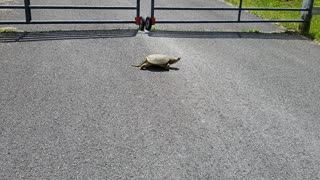Premium Only Content

Exclusive footage of the turtle leaving the egg.
Exclusive of the turtle part of the egg.
The turtle's falling from the age of a tenyear old in the same sect.
Turtles are large, ferocious creatures who don't like to be dealt with or even approached by humans. Weak on earth, they seem aggressive and fierce. In fact, they're not interested in attacking anyone, or anything, they only act defensively when they strike and try to bite. Their spiked beaks are strong enough to cause a cut and cause pain, although they are not in fact able to cut off a finger or a limb as popular folklore suggests. This is a common biting turtle, not a snapper crocodile, which is an important distinction. A common muscular turtle weighs up to 18 kg (40 pounds) and has a strong jaw. The crocodile turtle weighs up to 45 kg (100 pounds) and has the jawbone strength several times greater. The tubby turtle is definitely able to take off a finger or worse. Common biting turtles are not dangerous to humans. They live in almost all the lakes and rivers of North America, even though people rarely see them in the water. They are often confronted when they cross the road in spring or autumn. This happens when they are likely to move to find a place to lay eggs, or when males look for places to feed or reproduce better. Slowly moving turtles are killed by cars as roads and highways cross. Well-meaning motorists will stop to help these creatures, and it is not difficult to do so safely. The important thing is to determine where the turtle is headed. It'll help keep him from returning to danger simply after he's moved off the road. It's also important to lift it in a way that prevents injury to both man and the turtle.
-
 1:00
1:00
KDRTV Kenya News
4 years ago"LIFE IS PRECIOUS, SO LIVE IT WELL!" Exclusive footage of Jacob Black
216 -
 0:59
0:59
wildbluescience
5 years ago $4.01 earnedCamera attached to the back of a sea turtle delivers incredible footage
3.21K3 -
 0:12
0:12
kainduk
4 years agoTurtle love
75 -
 1:15
1:15
Myself
4 years ago $0.07 earnedTurtle PT.3
2391 -
 0:49
0:49
Myself
4 years ago $0.07 earnedTurtle PT.2
225 -
 0:50
0:50
tracy76
5 years ago $0.07 earnedTurtle crossing
3831 -
 0:44
0:44
maks1979
4 years agoBeautiful big turtle
107 -
 0:34
0:34
Boroda
4 years agoturtle eating fish
1302 -
 0:14
0:14
thorshoes
5 years agoLeaving PR
154 -
 0:28
0:28
garik7405
4 years agoLarge sea turtle.
69